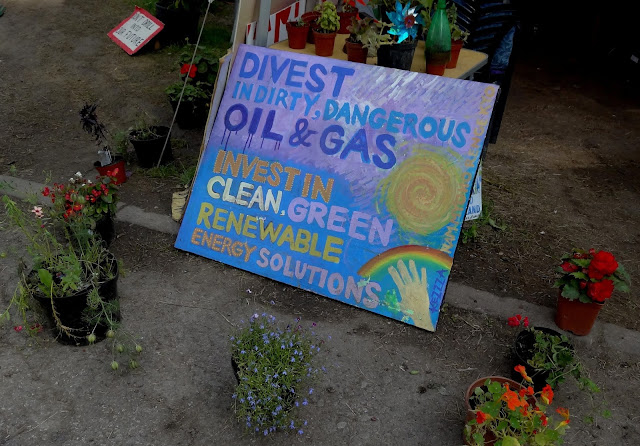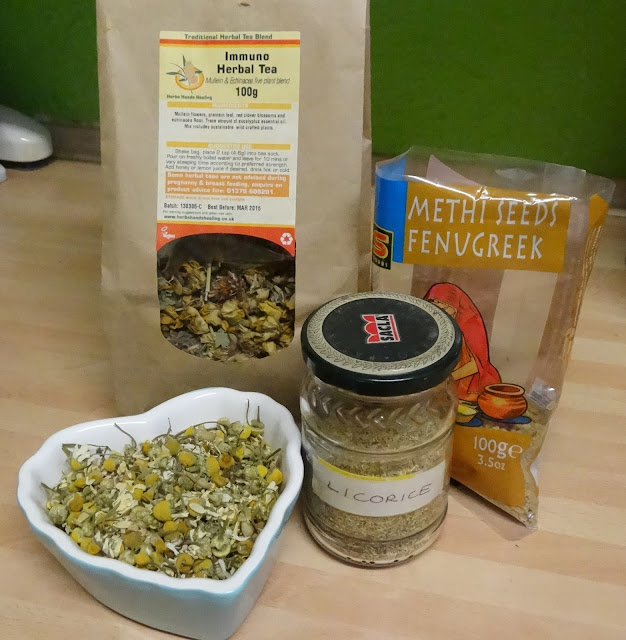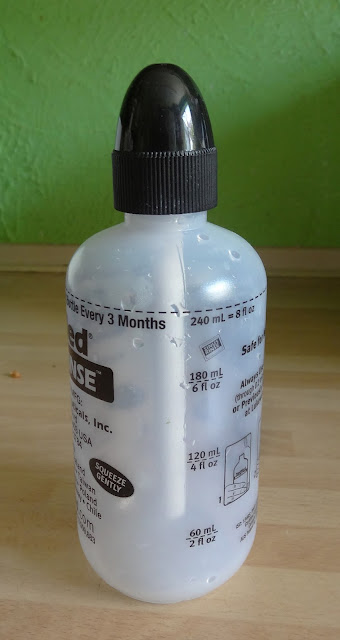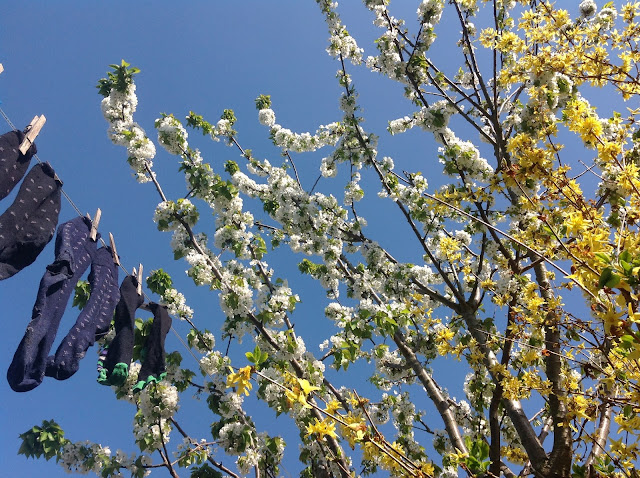At the same time as plans for fracking across 60% of the country are being proposed which will not only devastate wildlife and the very nature of our landscape but have the capability to contaminate the water we drink, the air we breathe and pose such largescale health risks to the population of this country (human and non-human alike) that I find it actually quite unimaginable.
And of course the list goes on...
Which makes it a very good time to think about the people who are organising and taking action and not giving up in the attempt to change this world and move it from one of cruelty and greed to one of compassion and justice. One such person is my friend Joan Court, who has dedicated many decades to actively changing the world for the better and who is a constant inspiration to me.
 |
| Joan speaking at a recent demo in Cambridge against the cruel experiments on genetically modified mice. |
Every time I go and stay with Joan in Cambridge (which isn't nearly often enough) I love to hear the stories she can tell me from her truly amazing life of the last 94 years, as well as the current affairs that we might discuss.
Back in 1989, when I'd just moved to Cambridge as a student (at the now named Anglia Ruskin Uni) I rang the contact number I'd found for Cambridge Animal Rights and two days later I was meeting up with Joan, Hilda, and others who I was to become close friends with, to go and inspect a pig farm, which began a busy time of animal rights campaigning and a new social life!
Having previously published two biographical books, Joan has recently published a third book which is a collection of pesonal interviews with over 20 animal rights activists. These provide a rare insight into the views and motivations of a diverse range of people who despite some differences in outlook share a common vision - that of animal liberation and an end to cruelty and abuse of those we share this world with. Acting in the interests of this vision has changed the course of lives and has not always been easy, sometimes leading to conflicts in personal lives or imprisonment. Through this book, Joan has provided the opportunity to get a glimpse of some of the real people behind the often dehumanising portrayals by the mainstream media of 'animal rights activists' or 'terrorists' as they have occasionally been depicted.
One of the recent times I stayed with Joan I asked if she would tell me about some of the times from her earlier life and I had the honour of spending a whole afternoon and morning listening to her fantastic memories and I took notes which I now share below (with her permission) as they deserve a wider audience.
As with any conversation that takes place at Joan's home, it has to be paused regularly to say hello to a cat, to make space on a lap, or to be mesmerised temporarily by the intense gaze of a beautiful pair of feline eyes. So in the spirit of the environment in which this conversation took place, the text pauses every now and then for one of Joan's cat family to wander through and bathe in a little attention.
Thanks again Joan, and I look forward to coming back to see you again soon. And get some more stories ready because I never tire of listening to them! Much love always xxx
 |
| To read more of Joan's life and work, take a look at her two autobiographical books, along with her latest book, all of which are available from Amazon. |
From childhood I've felt empathy with animals and people which has led to a life spent campaigning for people and animals. I feel close identification with people too. I'm a dreamer, a romantic but have tried to actually do something about it.
It was a dream of my brother Peter and myself to go to India. I was intensely influenced by books, in particular Kipling, and also the history and social injustice of people living in this country, people living in poverty. I began reading about Ghandi. I became vegetarian and interested in Indian Independence and the work of saving the lives of mothers and babies in India.
This led to four years midwifery and nursing training. During the war I was a District midwife, delivering babies at home in London. I never saw a depressed mother during home deliveries and all were breastfed. We had to conduct the service during air-raids and the house allocated to us was bombed. I slept understairs with a cat, Emily, and the telephone beside me. I'd go out on my bicycle with the bag strapped on the back. Occasionally I would find myself walking beside the bicycle wondering what had happened after a bomb had dropped nearby. If needed,an ambulance would come out.
In spite of the bombs, it was quite a peaceful occupation, with mothers sitting up in bed, happy, while I bathed the baby or burnt the placenta on the fire. I'm quite critical of modern midwifery care - the medicalisation of childbirth. Midwives are not trained for breach or anything other than a 'normal' birth, when a midwife could be adequately trained for dealing with this at a home.
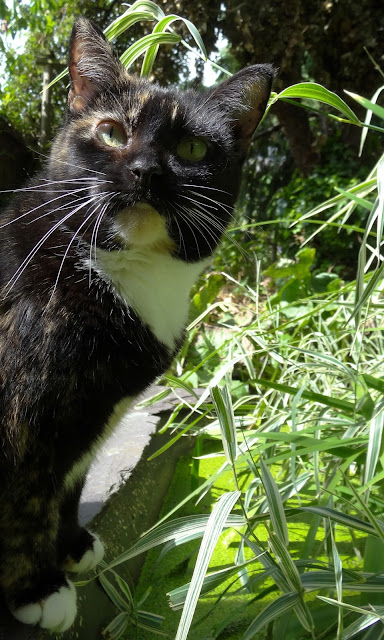 |
| Are you looking at me Katy the Shaman, do I need some healing? |
I was intent on going to India and got involved with the Quaker Unit operating in Calcutta and read research papers with recommendations on what could be done to reduce the maternal death rate. I had to get permission from the Viceroy then started a midwifery service in downtown Calcutta, working with Hindu nurses close to the Muslim area.
It's not difficult to reduce the death rate by improving antenatal care. The main deathrate was from tetanus often caused by the practice of applying cow dung to heal the naval. Most babies were delivered by untrained women. I helped to train local midwives and student midwives at the hospital.
I met Ghandi - everyone met Ghandi at that time. I worked with him briefly where he was in a village doing a hunger strike. I was asked to give him support. In my view, he's a Saint. He believed the future of India lay in the education of women. He was strictly vegetarian but like most Hindu's he believed in the importance of milk and wished there was a substitute for it, before the days of soya milk, so he travelled around with his goat.
 |
| He doesn't have paws... how did he get in?! |
The thing about my life, is I'm an intense romantic, but in my case all my dreams did come true. I did go to India, meet Ghandi, listen to EM Fortser...
But work in Calcutta was interrupted by riots against the British. After being mobbed once or twice I took to wearing sari's. I never came to any harm. The main danger was from the Ghurkas who seemed to shoot anybody in sight. About 7000 people were killed in a day or two around my area. They were brought in by the British during the Hindu-Muslim riots.
I was one of the few people with a permit to go out into the street. I would go out to both the Hindu and the Muslim areas to attend to mothers. I was very single-minded about reaching any patients in labour. I tried to take any injured people to hospital on a handcart. I wasn't able to take students out during riots.
We lived in a street which had five Hindu temples in one little area and worshippers would bring gifts of fruit etc, which had previously been offered to the gods and goddesses and consequently got dysentery. The flooded streets during the monsoon had rats floating everywhere and leaping around on rubbish dumps. As a consequence people would get Weil's disease and jaundice. Fortunately I had a good immune system having been brought up in such a filthy home! I think it's impossible to not get ill in Calcutta. Everyone working there had intestinal parasites. The diet was strictly vegan... rice and dahl or vegetable curry.
I still feel intense nostalgia for India and am sorry I didn't get back.
 |
| Hello Ming Ming, don't you be nibbling Joan's arm anymore please! |
I had a period of sick leave up in Kalimpong and Darjeeling, North India, with a view of the mountains and travelled up on a beautiful little steam train.
So I left India in October 1947 and saw the birth of an independent India and the Indian national flag flying in all the villages. Also the reconciliation of Hindus and Muslims, which didn't last of course. But when peace was restored in Calcutta, Hindus and Muslims were bathing each other in rose water and using their cutlasses to cut off the tops of coconuts instead of the heads of their enemies.
My time in Calcutta was the most intense time of my life. When in Calcutta I read about a horseback nursing service in Appalacia, America. It sounded a highly romantic job and you know what I'm like, so I returned to England and did my Public Health Visiting education. They were a bit reluctant to take me as I could neither drive nor ride a horse. But their attitude was "you sound the right sort" so I got the job!
I looked after 100 families, so called Hillbillies. It was a wonderful life and I fell in love with my horse Dock.
I look back on the days in Kentucky with a tremendous nostalgia. It was solitary, sometimes quite dangerous and pioneering. We gave total care to the families and their animals as far as we could, and if we had an emergency all the men would appear, make a stretcher and carry the mother to where they could hitch a ride on a coal-truck to the local hospital.
 |
| Ohhh Lily, you are too beautiful, I know! |
I'm really not very practical and I'm amazed to think I was once able to change a tyre and ride my horse up the creeks. I had to ride very slowly as I was carrying very expensive equipment in the saddle bags. People lived in extremely primitive homes with a central fire and no electricity. Babies were delivered by torchlight. The walls were decorated with old newspapers and magazines and slogans "Love Your Mother".
Some families made moonshine, illicit alcohol, which we were never allowed to discuss. Usually the fathers worked in open-cast mining, there were frequent accidents. All the children were infested with parasites and the wells were often contaminated from the latrines.
It was a wonderful service and I was happy that we were able to give first class midwifery and nursing care. It had many elements of danger and adventure which are in my blood stream.
When I came to the end of my contract I was offered several jobs, one with the WHO in Pakistan. An intense love affair with a Russian Jew which had begun in India and continued through my time in America, broke up and it was time to leave America. I accepted the WHO job in Pakistan as a midwife consultant advisor and subsequently worked in Turkey and Western Australia.
I got into difficulties in Pakistan due to establishing family planning in Lahore. The Government were opposed to it. The Minister said "we need men for the army". They tried to get rid of me, to send me to Africa. I also made an enemy in Pakistan (a WHO nursing officer) who said 'the trouble with you Joan,is you're more interested in social work than you are in nursing', and a light dawned!
 |
| Ah sweet Charlie, I didn't forget you |
Passionately keen on education, I began social work training in Bristol and London and qualified as a Psychiatric Social Worker. I joined the NSPCC, pioneering the treatment of what was then called 'Battered Baby Syndrome'. I got into difficulties with the Director for questioning NSPCC policy at the time. They'd prosecuted a young mother for harming her baby when I felt the fault lay with medical and social services, for not helping identify and support her with her problems. I refused to resign so they fired me.
I hadn't been out of work since my teens so I found this disturbing. I was offered a number of jobs and then someone suggested the DHSS. I didn't understand any of the questions but they wanted me so they could implement recommendations made by my unit over the last five years. I spent the next five years as an incompetent civil servant, advising the minister on family planning, child abuse, battered women etc. I was also asked to review all recent deaths of non-accidental injury and became an expert witness.
I met an old school friend, Mary Tew (Mary Douglas), Professor of Social Anthropology, read her book and thought I should have been a social anthropologist. I applied to the University of Cambridge and got accepted to do a degree in Social Anthropology. I had a Masters in Social Work from America but didn't have a first degree and thought I should have. That's how I came to Cambridge.
I continued to work as a Guardian Ad Litum until I was 77. This involved working with a solicitor as an independent social worker listening to the wishes of children and trying to make recommendations which were for their benefit.
In my second year at Newhall, I picked up leaflets about vivisection and this started the last 30 years of my life in Cambridge as an animal rights campaigner.
So I look back on my life which doesn't seem that unusual to me. I regard myself as impetuous, and I have a strongly developed imaginative life. I should perhaps mention that I always wanted to be a writer, as books have always been my lifeline, as they were for my brother too. I suffer from severe writers block but I have managed to publish three books, thanks to the enormous encouragement I've received from various sources.
I think I've got a very hard working Guardian Angel!
I've been active in all the main animal rights campaigns and resent the limits on ability of old age now which prevent me going on marches etc. We learn more and more about the horrendous and sadistic treatment of other sentient beings and it haunts our lives. Human beings have destroyed the seas, the sky and the earth but there's a great danger in apathy. I think we should continue to do whatever we can for animal rights and animal welfare and I deeply respect and honour all our fellow campaigners. I am sustained by my friends and companion animals.
 |
| Joan and Ming Ming, August 2013 |









